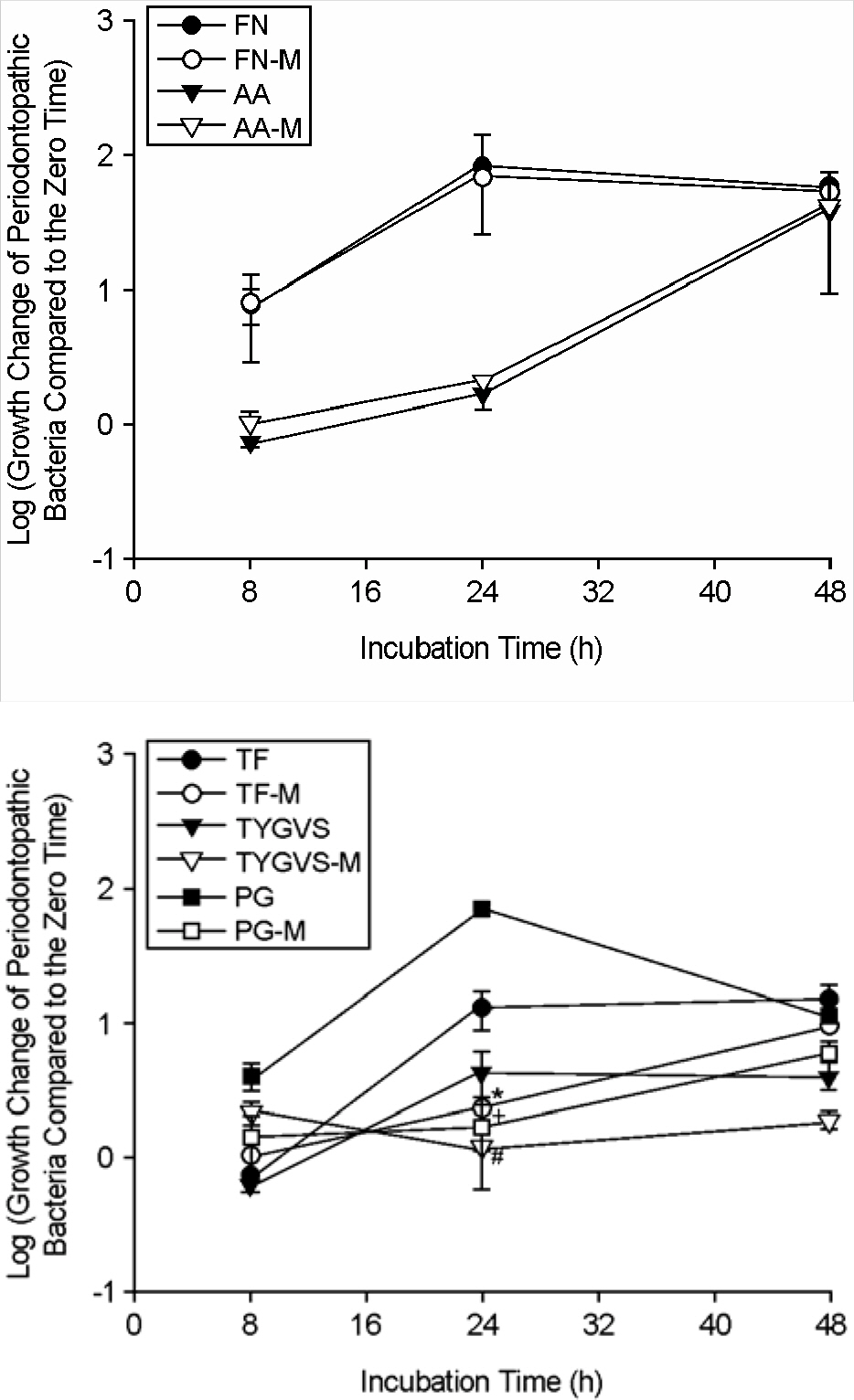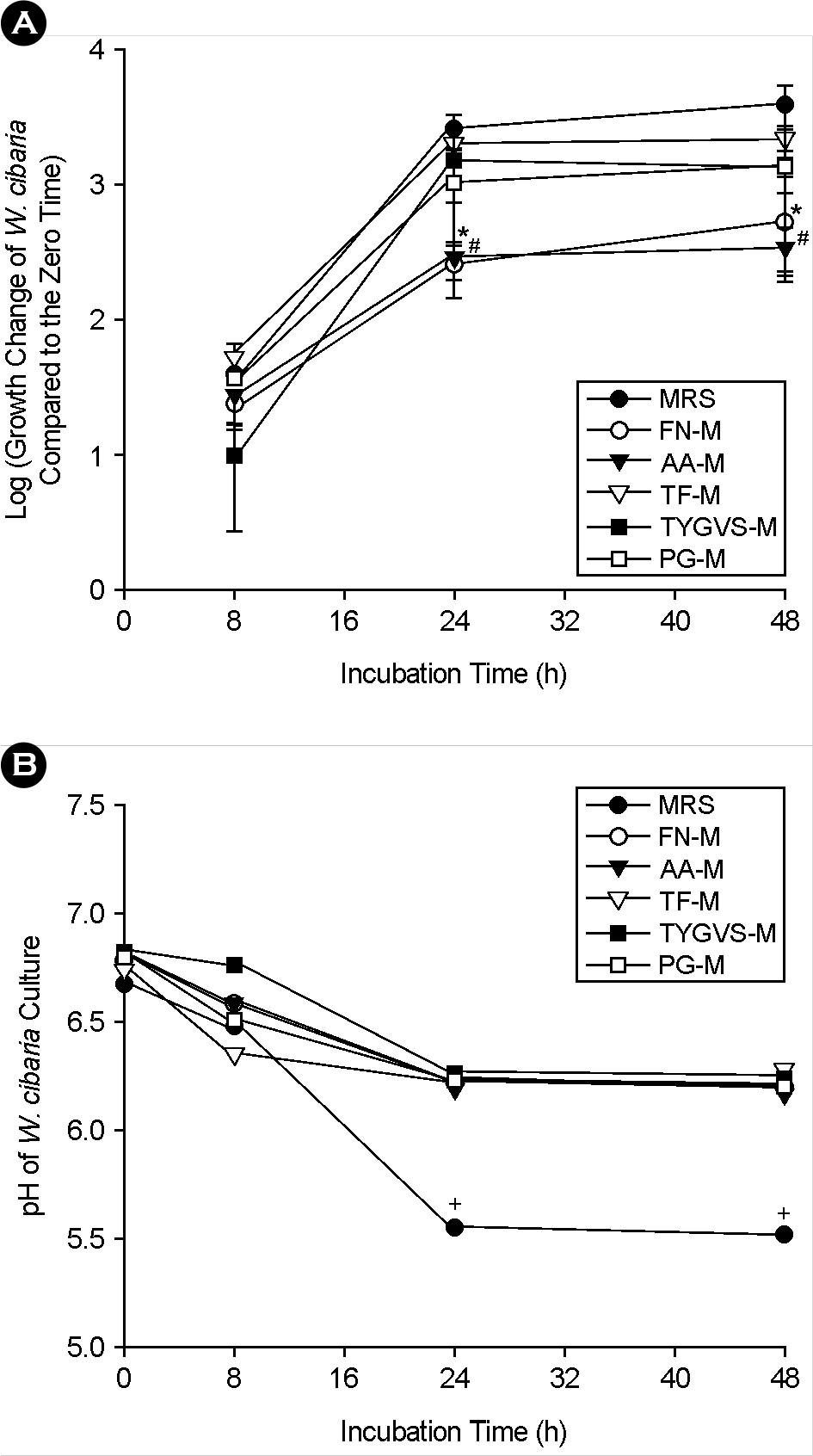J Bacteriol Virol.
2009 Dec;39(4):295-305. 10.4167/jbv.2009.39.4.295.
Quantitative Analysis of Weissella cibaria against Periodontopathic Bacteria by Real-time PCR
- Affiliations
-
- 1Department of Microbiology, School of Medicine, Chonnam National University, Gwangju, Korea. joh@chonnam.ac.kr
- 2Dental Science Research Institute, Chonnam National University, Gwangju, Korea.
- 3Department of Nursing, Chunnam Techno Colleage, Gokseong, Jeonnam, Korea.
- KMID: 2168541
- DOI: http://doi.org/10.4167/jbv.2009.39.4.295
Abstract
- The objective of this study was to analyze quantitatively whether Weissella cibaria could affect the proliferation of five periodontopathic bacteria, Porphyromonas gingivalis, Tannerella forsythia, Treponema denticola, Aggregatibacter actinomycetemcomitans, and Fusobacterium nucleatum, after incubation for 8~48 h. In addition, by using real-time PCR with a dual-labeled probe, each growth of bacteria was examined under different growth media conditions. The proliferation of periodontopathic bacteria was significantly inhibited by W. cibaria after incubation for 24~48 h (p < 0.05), whereas the growth of W. cibaria was not affected by these pathogenic bacteria. The growth of P. gingivalis, T. forsythia and T. denticola significantly increased in each growth media after incubation for 24 h (p < 0.05), as compared to the culture in mixed growth media. However, no differences in the growth of five periodontopathic bacteria were observed between each growth media and mixed media after incubation for 48 h. The growth and pH of W. cibaria culture significantly were changed in MRS after incubation for 24~48 h (p < 0.05), as compared to the bacterial culture in mixed growth media. The pH of P. gingivalis and F. nucleatum culture significantly was changed in both growth media and mixed media after incubation for 24~48 h (p < 0.05). Our data indicate that W. cibaria significantly inhibits the proliferation of five periodontopathic bacteria and each growth of bacteria is quantitatively analyzed under various media conditions by real-time PCR.
MeSH Terms
Figure
Reference
-
1). Papapanou PN. Epidemiology of periodontal diseases: an update. J Int Acad Periodontol. 1999. 1:110–6.2). Socransky SS., Haffajee AD. The bacterial etiology of destructive periodontal disease: current concepts. J Periodontol. 1992. 63:322–31.
Article3). Wiebe CB., Putnins EE. The periodontal disease classification system of the American Academy of Periodontology: an update. J Can Dent Assoc. 2000. 66:594–7.4). Poulet PP., Duffaut D., Lodter JP. Metronidazole susceptibility testing of anaerobic bacteria associated with periodontal disease. J Clin Periodontol. 1999. 26:261–3.
Article5). Roldan S., Herrera D., Santa-Cruz I., O'Connor A., Gonzalez I., Sanz M. Comparative effects of different chlorhexidine mouth-rinse formulations on volatile sulphur compounds and salivary bacterial counts. J Clin Periodontol. 2004. 31:1128–34.
Article6). Cho MJ., Hong SJ., Choi CH., Jeong SS. Effects of dentifrice containing extract of Galla rhois or Psoralea corylifolia on inhibition of plaque formation. J Kor Acad Dent Health. 2005. 29:141–52.7). Estafan D., Gultz J., Kaim JM., Khaghany K., Scherer W. Clinical efficacy of an herbal toothpaste. J Clin Dent. 1998. 9:31–3.8). Çaglar E., Kargul B., Tanboga I. Bacteriotherapy and probiotics' role on oral health. Oral Dis. 2005. 11:131–7.
Article9). Guarner F., Perdigon G., Corthier G., Salminen S., Koletzko B., Morelli L. Should yoghurt cultures be considered probiotic? Br J Nutr. 2005. 93:783–6.
Article10). Mandell RL. A longitudinal microbiological investigation of Actinobacillus actinomycetemcomitans and Eikenella corrodens in juvenile periodontitis. Infect Immun. 1984. 45:778–80.11). Haffajee AD., Socransky SS. Microbial etiological agents of destructive periodontal diseases. Periodontol 2000. 1994. 5:78–111.
Article12). Socransky SS., Haffajee AD., Cugini MA., Smith C., Kent RL Jr. Microbial complexes in subgingival plaque. J Clin Periodontol. 1998. 25:134–44.
Article13). Kato H., Yoshida A., Awano S., Ansai T., Takehara T. Quantitative detection of volatile sulfur compound-producing microorganisms in oral specimens using real-time PCR. Oral Dis. 2005. 11:67–71.14). Sakamoto M., Takeuchi Y., Umeda M., Ishikawa I., Benno Y. Rapid detection and quantification of five periodontopathic bacteria by real-time PCR. Microbiol Immunol. 2001. 45:39–44.
Article15). Suzuki N., Yoshida A., Nakano Y. Quantitative analysis of multi-species oral biofilms by TaqMan Real-Time PCR. Clin Med Res. 2005. 3:176–85.
Article16). Yoshida A., Suzuki N., Nakano Y., Oho T., Kawada M., Koga T. Development of a 5′ fluorogenic nuclease-based real-time PCR assay for quantitative detection of Actinobacillus actinomycetemcomitans and Porphyromonas gingivalis. J Clin Microbiol. 2003. 41:863–6.17). Stiles ME., Holzapfel WH. Lactic acid bacteria of foods and their current taxonomy. Int J Food Microbiol. 1997. 36:1–29.
Article18). Bjorkroth KJ., Schillinger U., Geisen R., Weiss N., Hoste B., Holzapfel WH., Korkeala HJ., Vandamme P. Taxonomic study of Weissella confusa and description of Weissella cibaria sp. nov., detected in food and clinical samples. Int J Syst Evol Microbiol. 2002. 52:141–8.19). Kang MS., Chung J., Kim SM., Yang KH., Oh JS. Effect of Weissella cibaria isolates on the formation of Streptococcus mutans biofilm. Caries Res. 2006. 40:418–25.20). Kang MS., Kim BG., Chung J., Lee HC., Oh JS. Inhibitory effect of Weissella cibaria isolates on the production of volatile sulfur compounds. J Clin Periodontol. 2006. 33:226–32.21). Kang MS., Choi EK., Choi DH., Ryu SY., Lee HH., Kang HC., Koh JT., Kim OS., Hwang YC., Yoon SJ., Kim SM., Yang KH., Kang IC. Antibacterial activity of pyrrolidine dithiocarbamate. FEMS Microbiol Lett. 2008. 280:250–4.
Article22). Ohta K., Makinen KK., Loesche WJ. Purification and characterization of an enzyme produced by Treponema denticola capable of hydrolyzing synthetic trypsin substrates. Infect Immun. 1986. 53:213–20.23). American Academy of Periodontology. Consensus report. Periodontal diseases: Pathogenesis and microbial factors. Ann Periodontol. 1996. 1:926–32.24). Lopez NJ. Occurrence of Actinobacillus actinomycetemcomitans, Porphyromonas gingivalis and Prevotella intermedia in progressive adult periodontitis. J Periodontol. 2000. 71:948–54.25). Lai CH., Listgarten MA., Shirakawa M., Slots J. Bacteroides forsythus in adult gingivitis and periodontitis. Oral Microbiol Immunol. 1987. 2:152–7.26). Tanner A., Maiden MF., Macuch PJ., Murray LL., Kent RL Jr. Microbiota of health, gingivitis, and initial periodontitis. J Clin Periodontol. 1998. 25:85–98.
Article27). Listgarten MA. Electron microscopic observations of the bacterial flora of acute necrotizing ulcerative gingivitis. J Periodontol. 1965. 36:328–39.28). Simonson LG., Goodman CH., Bial JJ., Morton HE. Quantitative relationship of Treponema denticola to severity of periodontal disease. Infect Immun. 1988. 56:726–8.29). Dzink JL., Tanner AC., Haffajee AD., Socransky SS. Gram negative species associated with active destructive periodontal lesions. J Clin Periodontol. 1985. 12:648–59.
Article30). Shimazaki Y., Shirota T., Uchida K., Yonemoto K., Kiyohara Y., Iida M., Saito T., Yamashita Y. Intake of dairy products and periodontal disease: the Hisayama Study. J Periodontol. 2008. 79:131–7.
Article31). Çaglar E., Sandalli N., Twetman S., Kavaloglu S., Ergeneli S., Selvi S. Effect of yogurt with Bifidobacterium DN-173 010 on salivary mutans streptococci and lactobacilli in young adults. Acta Odontol Scand. 2005. 63:317–20.32). Çglar E., Cildir SK., Ergeneli S., Sandalli N., Twetman S. Salivary mutans streptococci and lactobacilli levels after ingestion of the probiotic bacterium Lactobacillus reuteri ATCC 55730 by straws or tablets. Acta Odontol Scand. 2006. 64:314–8.33). Hatakka K., Ahola AJ., Yli-Knuuttila H., Richardson M., Poussa T., Meurman JH., Korpela R. Probiotics reduce the prevalence of oral Candida in the elderly-a randomized controlled trial. J Dent Res. 2007. 86:125–30.34). Kang MS., Na HS., Oh JS. Coaggregation ability of Weissella cibaria isolates with Fusobacterium nucleatum and their adhesiveness to epithelial cells. FEMS Microbiol Lett. 2005. 253:323–9.35). Boutaga K., van Winkelhoff AJ., Vandenbroucke-Grauls CM., Savelkoul PH. Comparison of real-time PCR and culture for detection of Porphyromonas gingivalis in subgingival plaque samples. J Clin Microbiol. 2003. 41:4950–4.36). Srionnual S., Yanagida F., Lin LH., Hsiao KN., Chen YS. Weissellicin 110, a newly discovered bacteriocin from Weissella cibaria 110, isolated from plaa-som, a fermented fish product from Thailand. Appl Environ Microbiol. 2007. 73:2247–50.
- Full Text Links
- Actions
-
Cited
- CITED
-
- Close
- Share
- Similar articles
-
- Adhesion of Weissella cibaria to the Epithelial Cells and Factors Affecting its Adhesion
- Effect of Weissella cibaria on Fusobacterium nucleatum-induced Interleukin-6 and Interleukin-8 Production in KB Cells
- Comparison of Temperature and Additives Affecting the Stability of the Probiotic Weissella cibaria
- Oral health condition according to distribution of periodontopathic bacterial complex
- Inhibitory effect of the probiotic bacteria, Weissella cibaria CMU on halitosis: a randomized placebo-controlled study





